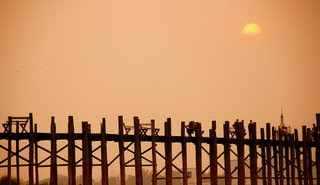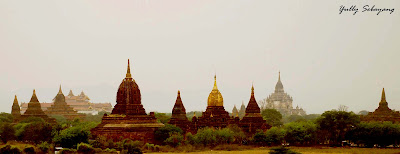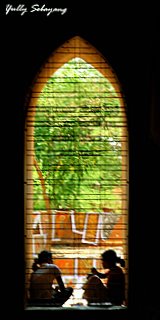Bagan view
Myanmar, officially Union Of Myanmar, also called Burma, is a bit bigger than France and slightly smaller than Texas, Myanmar covers 678,500 sq km, though it sometimes jockeys with neighboring Thailand for a hectare or two more along its eastern extremes. Its land border with ( clockwise from west ) Bangladesh, India, Tibet, China, Laos and Thailand, covers 5876km, and 1930km of coastline faces the Bay of Bengal and Andaman Sea. Myanmar is a land of mystifying contradictions, a country whose spirited people have withstood centuries of oppression, from Kublai Khan to King George VI to the present military regime.

Myanmar is endowed with a rich diversity of habitat types arising largely from its unusual ecological diversity. It is home to nearly 300 known mammal species, 300 reptiles and about 100 birds species, and a heaven for about 7,000 species of plant life. Since Myanmar considers such a rich pool of bio diversity as an important national asset, the Government has drawn up strict regulations to protect its biological resources.
 |
| Road to Mandalay |
 |
| Mandalay |
One of the more exciting aspects of travel in Myanmar is getting the opportunity to experience a corner of Asia that in many ways has changed little since British colonial times. Due to its isolation - self-imposed and otherwise Myanmar has yet to be completely overwhelmed by outside clothing influences. Nowhere else in Southeast Asia you will see so many sarongs, turbans and other exotic apparel.
Although isolated, subjugated and poor, the Myanmar people can be as proud of their country and culture as any nationality you’ll meet. About 11% of Myanmar’s 52 million people live in the capital, Yangon. It’s estimated, though, that seven in 10 people are involved in agriculture.
 |
| Burmese woman carrying baby |
 |
| Burmese young girl carrying her little brother |
Officially Myanmar’s residents ( not including Chinese, Indian, Nepalese, and other groups ) are divided into eight nationalities. The Bamar ( also known as Burmese ), Shan, Mon, Kayin, Kayah, Chin, Kachin and Rakhaing.
 |
| Tapestry making |
About 87% of the people of Myanmar are Buddhist, there are as many as 500,000 monks, and there are over 50,000 Monasteries in Myanmar. In Myanmar, women who live the monastic life as dasasila ( ‘10-precept’ nuns ) are often called Thilashin ( possessor of morality ) in Burmese. Myanmar nuns shaved their heads, wear pink robes, and take vows in an ordination procedure similar to that undergone by monks.
 |
| Young monks |
 |
| Nuns |
Myanmar is a country of Zedish, often called ‘pagodas’ in English. Wherever you are, boating down the river, driving through the hills, even flying above the plains, there always seems to be a hilltop Zedi in view.
 |
| Pagodas |
I spent seven days in Myanmar with other two SSA ladies, my dear friends

Angeli Parapat, SSA Kemaman ( Indonesian ) and Nanda Tun, SSA Kemaman ( Burmese ) which I met when I lived 13 months in
Kemaman,
Malaysia, and with one friend Burmese lady ( not from SSA ). We spent three days in Yangon, two days in Mandalay and another two days in Bagan. I enjoyed so much traveling in Myanmar, as I love the Burmese cuisine, which are most commonly fish, chicken, prawns or mutton. Very little beef or pork is eaten by Burmese Buddhist. My favorite was
Mohinga ( noodles with chicken or fish ) for breakfast.
The best time to visit Myanmar is between November and February. During this months it rains least ( if at all in places ) and it is not so hot. March to May brings intense heat, ( April is the cruelest month, unfortunately we went there on April ). At this time Yangon’s daily temperature often reach 40 Degree Celsius, while areas around Bagan and Mandalay go a few digits higher.
 Yangon
Yangon formerly Rangoon, gives the impression of picturesque dishevelment, a half finished work in progress, and it’s the most multiethnic, cosmopolitan, and interesting city in Myanmar. The highlight of any trip to Yangon has to be Shwedagon Paya, has achieved iconic for Yangon. The most sacred Buddhist site in the country. The central gilded stupa rises 98m above the base, and can be seen glittering in the distance from much of the city. Though it’s a pretty busy place, it still has a peaceful atmosphere. There are many other payas around the city, and the markets are well worth a visit.
 |
| Public telephone in on the road (Yangon) |
 |
| Karaweik, Yangon |
Mandalay
For many, Mandalay typifies the romance of the Raj. In fact, it’s quite a modern city, founded in the mid 1800s, it was capital for only about 30 years until the British took it in 1885. More recently, trade with China has become a strong influence. The city is laid out on a grid system, and sprawls a long way from the bottom of Mandalay hill, so getting around on foot is not really practical.
 |
| Mahamuni Paya, Mandalay |
 |
| Mandalay Royal Palace |
Mandalay’s most worshipped site, the Mahamuni Paya, the 4m-highh seated Buddha image is cast in bronze, but over the years thousands of devout Buddhist have completely covered the figure in a 15cm-thick layer of gold leaf.
The hill with the huge grounds of Mandalay Palace as its base is the natural focus of Mandalay. The city sprawls away to the south and west of the fort, bounded on the west by the Ayeyarwady River.
 |
| Young monk passing the U bein's bridge |
 |
| U bein's bridge, Mandalay |
 |
| U bein's bridge |
Amarapura, 11km south of Mandalay is the location of the famous U Bein’s bridge, a teak walkway (the longest of its kind in the world) across Taungthaman lake. It has an atmosphere all of its own, as the late afternoon light illuminates the locals wheeling their bicycles home across the bridge. Nearby is Mahagandhayon Kyaung (monastery), where if you visit in the morning, you’ll find several hundred young monks eating breakfast in silence.
 |
| Young monks |
 |
| Young monks lining for taking breakfast, Mandalay |
 |
| Young monks taking breakfast |
Bagan
 |
| Pagoda in Bagan |
 Bagan
Bagan is the highlight of a trip to Myanmar, or indeed Asia, Bagan is amazing. More than 3000 pagodas, dating from between the 9th and 13th centuries, cover an area of some 40 square kilometers in a bend of the Ayeyarwaddy. Elsewhere in central Myanmar are the ‘lost cities of the dry zone’. Bagan was the end of our trip to Myanmar, The light’s obviously at its best at the start and end of the day, when people gather at some of the taller monuments to watch the sun rise/set over the Bagan skyline. We discovered that the Burmese are a gracious people, and usually happy to be the subject of our photography, that Burma is such a beautiful country, I would love to go back as there are still many places I should visit in the future.
All photographs copyright by Yully Sebayang








 Angeli Parapat, SSA Kemaman ( Indonesian ) and Nanda Tun, SSA Kemaman ( Burmese ) which I met when I lived 13 months in Kemaman, Malaysia, and with one friend Burmese lady ( not from SSA ). We spent three days in Yangon, two days in Mandalay and another two days in Bagan. I enjoyed so much traveling in Myanmar, as I love the Burmese cuisine, which are most commonly fish, chicken, prawns or mutton. Very little beef or pork is eaten by Burmese Buddhist. My favorite was Mohinga ( noodles with chicken or fish ) for breakfast.
Angeli Parapat, SSA Kemaman ( Indonesian ) and Nanda Tun, SSA Kemaman ( Burmese ) which I met when I lived 13 months in Kemaman, Malaysia, and with one friend Burmese lady ( not from SSA ). We spent three days in Yangon, two days in Mandalay and another two days in Bagan. I enjoyed so much traveling in Myanmar, as I love the Burmese cuisine, which are most commonly fish, chicken, prawns or mutton. Very little beef or pork is eaten by Burmese Buddhist. My favorite was Mohinga ( noodles with chicken or fish ) for breakfast. Angeli Parapat, SSA Kemaman ( Indonesian ) and Nanda Tun, SSA Kemaman ( Burmese ) which I met when I lived 13 months in Kemaman, Malaysia, and with one friend Burmese lady ( not from SSA ). We spent three days in Yangon, two days in Mandalay and another two days in Bagan. I enjoyed so much traveling in Myanmar, as I love the Burmese cuisine, which are most commonly fish, chicken, prawns or mutton. Very little beef or pork is eaten by Burmese Buddhist. My favorite was Mohinga ( noodles with chicken or fish ) for breakfast.
Angeli Parapat, SSA Kemaman ( Indonesian ) and Nanda Tun, SSA Kemaman ( Burmese ) which I met when I lived 13 months in Kemaman, Malaysia, and with one friend Burmese lady ( not from SSA ). We spent three days in Yangon, two days in Mandalay and another two days in Bagan. I enjoyed so much traveling in Myanmar, as I love the Burmese cuisine, which are most commonly fish, chicken, prawns or mutton. Very little beef or pork is eaten by Burmese Buddhist. My favorite was Mohinga ( noodles with chicken or fish ) for breakfast. Yangon formerly Rangoon, gives the impression of picturesque dishevelment, a half finished work in progress, and it’s the most multiethnic, cosmopolitan, and interesting city in Myanmar. The highlight of any trip to Yangon has to be Shwedagon Paya, has achieved iconic for Yangon. The most sacred Buddhist site in the country. The central gilded stupa rises 98m above the base, and can be seen glittering in the distance from much of the city. Though it’s a pretty busy place, it still has a peaceful atmosphere. There are many other payas around the city, and the markets are well worth a visit.
Yangon formerly Rangoon, gives the impression of picturesque dishevelment, a half finished work in progress, and it’s the most multiethnic, cosmopolitan, and interesting city in Myanmar. The highlight of any trip to Yangon has to be Shwedagon Paya, has achieved iconic for Yangon. The most sacred Buddhist site in the country. The central gilded stupa rises 98m above the base, and can be seen glittering in the distance from much of the city. Though it’s a pretty busy place, it still has a peaceful atmosphere. There are many other payas around the city, and the markets are well worth a visit. 










 Bagan is the highlight of a trip to Myanmar, or indeed Asia, Bagan is amazing. More than 3000 pagodas, dating from between the 9th and 13th centuries, cover an area of some 40 square kilometers in a bend of the Ayeyarwaddy. Elsewhere in central Myanmar are the ‘lost cities of the dry zone’. Bagan was the end of our trip to Myanmar, The light’s obviously at its best at the start and end of the day, when people gather at some of the taller monuments to watch the sun rise/set over the Bagan skyline. We discovered that the Burmese are a gracious people, and usually happy to be the subject of our photography, that Burma is such a beautiful country, I would love to go back as there are still many places I should visit in the future.
Bagan is the highlight of a trip to Myanmar, or indeed Asia, Bagan is amazing. More than 3000 pagodas, dating from between the 9th and 13th centuries, cover an area of some 40 square kilometers in a bend of the Ayeyarwaddy. Elsewhere in central Myanmar are the ‘lost cities of the dry zone’. Bagan was the end of our trip to Myanmar, The light’s obviously at its best at the start and end of the day, when people gather at some of the taller monuments to watch the sun rise/set over the Bagan skyline. We discovered that the Burmese are a gracious people, and usually happy to be the subject of our photography, that Burma is such a beautiful country, I would love to go back as there are still many places I should visit in the future. 


6 comments:
mas yully, blog nya luar biasa sekali!
sering travelling ya?
salam kenal ...
Thank you Mbak Nien, tapi saya bukan mas, saya cewek.... :)
Iya seneng traveling, salam
Jeng Yully, masa' sih gak bisa pake shoutbox? Ntar dakuh protes dulu sama si sb ya... :D
Btw, aku punya temen orang Myanmar, pegawai pemerintahan. Walaupun orangnya lucu, tapi dia sering salah tingkah kalo ngomongin soal negerinya. Kayak takut kepergok mata2 gitu. Kalo sebagai orang asing, kita berasa dibayangi gitu juga gak disana? *yang lagi nimbang2 utk nolak undangan berkunjung si temen tadi*
Kesana deh mbak, bagus banget tempat2nya, kalo suka sama yang agak2 tradisional dan terbelakang. Asal jangan ngomongin ttg pemerintah mereka aja ga pa pa sih :)
nice pics!!
:O)
cool, sist !! very good job, yul .. Bravo ! :)
Post a Comment